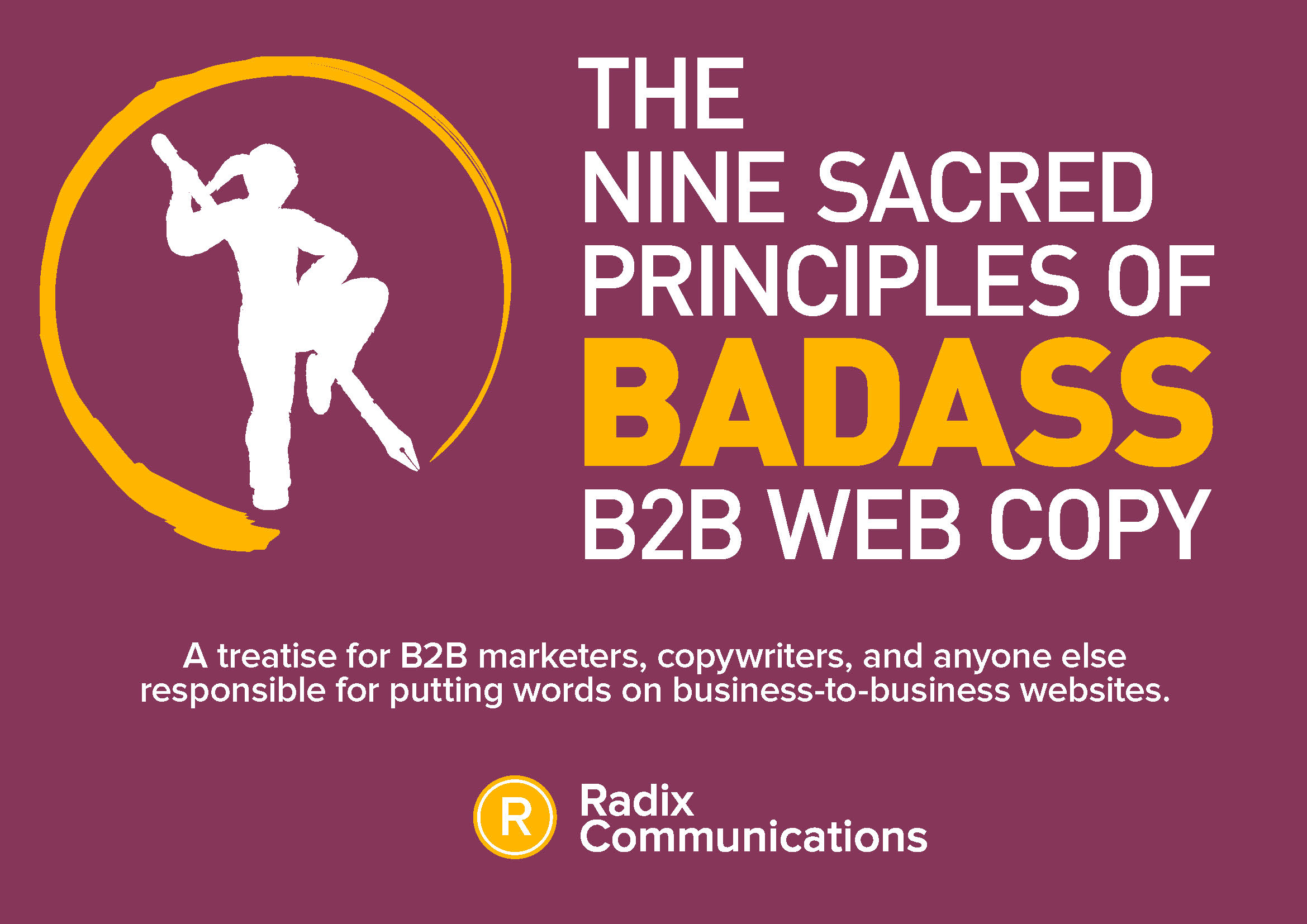The customer is always right.
It’s a mantra that’s stood businesses in good stead for centuries. But its meaning goes far beyond the customer service advisor nodding along while being shouted at by a customer.
In B2B today, websites are usually the business battleground. With so many alternatives a click away, you have to get it right to stay competitive. And here too, the customer (or the reader) needs to come first.
So why do so many B2B sites manage to get it wrong?
In the copywriting world, we’re used to hearing horror stories of businesses that start new website projects from a design point of view, and end up neglecting the copy altogether. The result is a completely new website in appearance, but with the same old copy or, worse, copy that was hastily cobbled together at the end of the project.
Content like that is always going to let your customer down.
In an interview for Business Reporter, Good Growth’s James Hammersley used the M&S failed website reboot of 2013 and its 8.1% drop in sales, to highlight the perils of failing to put the customer first. He states the answer to creating better websites is rarely a technology issue – or even a new website altogether.
It’s thinking about your customer. And often, that’s a writing thing.
So to avoid a costly nightmare before undertaking any web copy project, ask yourself these nine vital questions (they’re taken from David’s Nine Sacred Principles of Badass B2B Web Copy):
Question 1: What are we trying to achieve?
Think of any website you truly admire. I’ll hazard a guess and say it’s simple, informative, and gets to the point – right? It tells you exactly what you’re looking for, with minimal effort on your behalf. That’s the essence of great web copy.
At each stage you need to ask yourself: “so what?”. It’s a really good way of checking your copy and you’ll likely highlight anything unnecessary. If you find something that doesn’t help you achieve your goal, get rid of it straight away.
And one last thing: doing something because your competitors are doing it isn’t a good enough reason. Make sure all your decisions are backed up by experience, data, and a clear sense of purpose.
Watch: The First Principle of Badass B2B Web Copy – Clarity.
Question 2: What does the customer want to read first?
You’re not special. There, I said it.
And neither’s your website. Given that there are currently… [Googles]… 1.3 billion websites in the world, chances are at least some of them do exactly what you do.
So when someone finds one of your pages, what’s the first thing they see? Lots of copy? Stock photos? Aspirational words? If you don’t know already, that’s a big red flag.
Why? Because what’s important to you may not be important to your visitors. And if you don’t grab their attention within the first line, you’ll likely lose them to one of those other sites. For good.
So think about where your visitor has arrived from (perhaps Google, a social share, or another referring page). This tells you what they’re expecting to find… and you can use that thought as the basis for your copy brief.
And remember, keep it simple.
Watch: The Second Principle of Badass B2B Web Copy – Focus
Question 3: What does the reader truly care about?
Or more precisely, what are their problems, and how can they begin to overcome them?
Simply, it’s not all about you. In fact, it’s not about you whatsoever. You need to speak your customer’s language and talk how they talk.
That’s easier said than done because, let’s be honest, you’re programmed to believe your product or service is the best. But you need to keep quiet about that (for now at least).
Instead, you need to demonstrate that you understand the reader’s issues, and that you have solutions.
Watch: The Third Principle of Badass B2B Web Copy – Perspective
Question 4: What information are they really trying to find?
Take a moment to think about your current web pages. Are they pages that you think your customers want, or pages your customers actually want? Often, there’s a big difference – and this is where you need hard data to back up your decisions.
Luckily, there are a couple of simple things you can do to discover what your customers want, without even asking them directly:
Web analytics: find out which pages people predominantly arrive at, and where they go to from there. Also, consider the search engine terms (keywords) they used to get there.
Search: if you’ve got a search box on your site, the terms people have entered into it are a goldmine of information. This will also tell you the kind of words and terminology customers prefer to use, i.e. if you’re not using the words your customers are using, they’re not going to find what they’re looking for.
Indeed, the same principle can be applied to Google. Things like Google Trends can be a treasure trove of insight into the words and phrases people are using when looking for something in particular.
Watch: The Fourth Principle of Badass B2B Web Copy – Kindness
Question 5: What language does our customer use?
Back in the day, copywriters were often given a spreadsheet of “keywords” to smuggle into the copy. And if they were lucky, they’d get this before writing, and not be expected to crowbar them in afterwards.
Thankfully due to a change in Google’s algorithms, keyword-crowbarring is now a rare request (and one we can comfortably decline). It leaves copywriters to instead focus on writing valuable content that strikes a chord with readers.
That’s not to say that SEO and keyword research no longer matter – far from it. We still get the spreadsheets, and they’re still valuable. It’s just that now we use them to help us write for people, not just for Google. Because they tell us the words that your audience can relate to.
Watch: The Fifth Principle of Badass B2B Web Copy – Empathy
Question 6: Do we have something genuine to say?
If you don’t – no matter how hard you try – your audience will see right through you. And remember you for it as well.
You come across examples of it every day. Think about the clickbait links you see at the bottom of genuine online articles. And now consider the poor fool who’s had to write that content because they have nothing constructive or interesting to say.
It’s an important factor when writing copy. No matter how much you want a shed-load of traffic to go to your website, there’s absolutely no point in trying to trick people into coming to it, if all they do when they arrive is shrug, and click “back”.
(Here’s a hint: if you’re thinking “traffic”, and not “reader”, you’re doing it wrong.)
Watch: The Sixth Principle of Badass B2B Web Copy – Integrity
Question 7: How quickly will they get the point?
B2B web copy needs to work on several levels – because that’s how people read.
There’s the five second-skimmer who’ll be fairly random about where they look – focusing on titles, captions and bullet points. But there’ll also be the detailed readers, who want as much information as possible. And everyone in between.
And guess what? Your website copy needs to accommodate every one of them.
Simply, your copy needs to be straightforward and do exactly what it says on the tin. Otherwise it’ll cause confusion and drop off. This also goes for you other copy (print, emails and adverts).
Watch: The Seventh Principle of Badass B2B Web Copy – Consistency
Question 8: What do we want them to do next?
To avoid the risk of visitors dropping off a website, a good copywriter will always give users an escape route from a particular page.
This could be in the form of a call to action or a link to another connected page within the same website. But if the copy just kind of…stops, your visitors won’t see any logical next step or action. They will simply leave.
So what do you do? Simple – have the natural next step in mind from the moment you start writing the copywriting brief.
Watch: The Eigth Principle of Badass B2B Web Copy – Prescience
Question 9: How should we order the site creation?
Think of your website like a big tree. Your homepage is the trunk. And the roots, they’re what feeds it – say, referrals from Google. (Or Bing. Hey, it could happen.) And your leaves and branches? They’re every other page on the site.
It might sound counter-intuitive, but when writing a website, it’s always best to start with the leaves, then the branches. That’s where your bread and butter is – the really granular detail.
Once you know how you’re delivering these arguments, it’s easier see the themes and the highlights, and to be consistent as you work your way back, through the branches, to the trunk.
So if you can, brief your writer on the detail first, then zoom out.
Watch: The Final Principle of Badass B2B Web Copy – Patience
Nine easy steps – simple, right?
Website copywriting projects are seldom as straightforward as they seem. And hitting the mark rarely comes easy.
Websites that appear simple probably look that way because they took the longest to craft and refine. But once you have the basics down, the rest is a process of test and learn – figuring out what works, what doesn’t, and refining accordingly.
If you’re in doubt, think about your reader. In the end, they’re all that matters anyway.
Want more detail? Grab The Nine Sacred Principles of Badass B2B Web Copy. (It’s free, and we won’t even ask you for your email address.)



